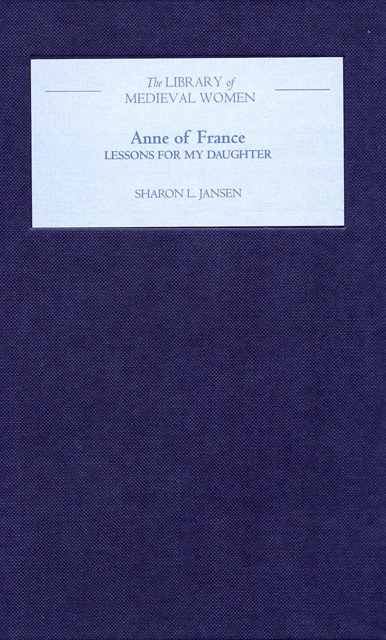Book contents
- Frontmatter
- Contents
- Dedication
- Preface
- Preface to the Paperback Edition
- Introduction
- A Note on the Translation
- Lessons for my Daughter
- Interpretive Essay
- Appendix I Louis XI, Anne of France, and the Regency Question
- Appendix II Unpublished Letters from Anne of France
- Select Bibliography
- Index
- Already Published Titles in this Series
- Frontmatter
- Contents
- Dedication
- Preface
- Preface to the Paperback Edition
- Introduction
- A Note on the Translation
- Lessons for my Daughter
- Interpretive Essay
- Appendix I Louis XI, Anne of France, and the Regency Question
- Appendix II Unpublished Letters from Anne of France
- Select Bibliography
- Index
- Already Published Titles in this Series
Summary
Anne of France, Madame la Grande
One of the most powerful women of the late fifteenth century, Anne of France is relatively unknown today, at least to those of us whose first language is English. While she is occasionally mentioned in the political biographies of her father, Louis XI of France, and her brother, Charles VIII, her own story remains unfamiliar, and the book of advice she composed for her daughter was last edited in the nineteenth century and has never before been translated into English. Yet in the waning years of the fifteenth century, Madame la Grande, as she was known to her contemporaries, controlled the government of France for eight years, guiding it through a series of political crises that threatened the state from without and, perhaps more ominously, from within.
Born in 1461, Anne was the third child of Louis of France and his second wife, Charlotte of Savoy, but the first to survive more than a few months after birth. Although we know where she was born—at the chateau of Genappe, some thirty miles north of Brussels—we do not know exactly when, only that her birth preceded the death of her grandfather Charles VII on 22 July of that year. Only a few months after her father became king, he began the process of securing political alliances through her marriage. On 27 November 1461, Louis betrothed his only child to Nicholas, the grandson of René of Anjou; by the end of 1462, that alliance was abandoned in favor of an Aragonese match, that project, in turn, giving way to proposals for her marriage to Edward IV of England, then to Francis of Brittany, and even to the French king’s own brother, Charles, duke of Berry.
Meanwhile, we have very few details about Anne’s childhood. On becoming king, Louis XI had installed his mother, his wife, and his infant daughter in the chateau of Amboise; there, the princess was attended by a demoiselle d’honneur, at least two chambermaids, several nurses, and a woman hired to rock her cradle. This female household has not been kindly assessed by Anne’s French biographers, who variously describe Amboise as a prison, an isolated fortress, or as a “royal gynecium”; we might instead regard it as a kind of “city of ladies,” a remarkable environment that made possible the development of a remarkable woman.
- Type
- Chapter
- Information
- Anne of FranceLessons for my Daughter, pp. 1 - 22Publisher: Boydell & BrewerPrint publication year: 2004

